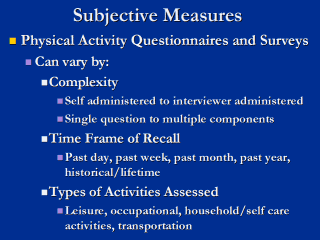| front |1 |2 |3 |4 |5 |6 |7 |8 |9 |10 |11 |12 |13 |14 |15 |16 |17 |18 |19 |20 |21 |22 |23 |24 |25 |26 |27 |28 |29 |30 |31 |32 |33 |34 |review |
 |
Questionnaires and
Surveys are subjective instruments used in epidemiological research to
quantify physical activity. Physical activity questionnaires/surveys can
vary by complexity, time frame or recall, and types of activities surveyed.
Complexity. Physical activity questionnaires can vary in complexity by the manner in which it is administered (self vs. interviewer). They can also vary from the use of a single question to more complex questionnaires that attempt to survey a wide range of popular activities over a predetermined period of time. Time Frame of Recall. Questionnaires/surveys may inquire about usual activity done within the past day, past week, past month, past year, or even over one’s entire lifetime. Types of Activities. Early studies in physical activity epidemiology estimated one’s physical activity based on the activities that were performed at work. However, as a country becomes more industrialized, the amount of physical activity accumulated on the job and/or as a means of transportation declines. As a result, investigators shifted towards questionnaires and surveys that measured only leisure-time physical activity. In addition, for older or diseased populations the assessment of lower intensity activities, such as household or activities of daily living may be necessary when determining one’s physical activity status. Subjective measures are less likely to capture lower intensity activities because it is often difficult to accurately recall lower intensity types of physical activity such as housework and childcare. For accurate assessment of low intensity activity, objective measures are needed. Recommended Readings: Kriska AM and Caspersen CJ (1997). Introduction to the Collection of Physical Activity Questionnaires in A Collection of Physical Activity Questionnaires for Health-Related Research. Centers for Disease Control and Prevention. Medicine and Science in Sports and Exercise, 29 [Supplement]. |